National Geographic content straight to your inbox—sign up for our popular newsletters here


Step inside Cold War nuclear sites
Contemplating cataclysmic destruction isn't exactly relaxing. So why do hundreds of thousands of tourists visit these decommissioned missile sites?
Grey, cushioned, comfortable, the chair doesn’t seem meant for a combat position on the front line of nuclear war. Yvonne Morris sat there on alert in the early eighties. Now, when she leads tours, she steers visitors through simulations of the steps she never had to take: Authenticate the controller's flat, dire command; retrieve the launch codes from the war safe; turn the keys in unison with the deputy crew commander to send a seven-story-tall Titan II intercontinental ballistic missile and its massive nuclear payload hurtling off into the world.
That’s when Morris—a former missile combat crew commander and current director of the Titan Missile Museum —tells the tourist they’ve failed. If the mission to maintain peace through deterrence had been successful, the bomb would never have launched.

In 2018, it’s an effective simulation. But at several points in the last seven decades, most people wouldn’t have needed any help imagining the start of a nuclear war. There were some years where nobody forgot that absolute, omnipresent threat. And though it's gone largely unnoticed for years, current events—and increasing nuclear tourism—are bringing it back into the spotlight.
Anxiety and inattention form a repeated pattern when it comes to nukes, suggests Paul Boyer in his book By the Bomb’s Early Light: American Thought and Culture at the Dawn of the Atomic Age .

A game of Battleship waits in the day room at MMNHS. Missile crew members had mandated breaks during their 24-hour alerts, and a guaranteed rest day following.
In the years immediately following World War II, the United States had an “obsessive post-Hiroshima awareness of the horror of the atomic bomb,” Boyer writes. By 1950, it had faded. But in the mid-fifties, fallout from American and Russian atmospheric bomb tests—miles of ash, dead fishermen, radioactive rain, radioactive milk—renewed public terror. [ See photos taken on illegal visits to Chernobyl’s dead zone. ]
The national preoccupation with nuclear war nearly disappeared again after the 1962 Cuban Missile Crisis, thanks to a test-ban treaty and the growing impenetrability of nuclear technology and strategy. And though fears of nuclear war resurged during the global proxy conflicts of the eighties, another wave of disinterest followed after the Cold War’s end in 1991: The Strategic Arms Reduction Treaty (START I) saw the U.S. and the U.S.S.R agree to reduce their deployed nukes, and people were eager to think the threat had passed.
All the while, thousands of warheads remained buried on high alert beneath ranches, homes, and highways.
Underground on the front lines
At ground level, the missiles were nearly invisible, their presence marked by antennae, barbed wire fences, and the launch duct door like a small basketball court.
“From a distance, it looks like something unremarkable,” says Eric Leonard, superintendent at the Minuteman Missile National Historic Site (MMNHS) in South Dakota . Then you get close enough to read the signs: Use of deadly force authorized. “The distance between mundane and extraordinary is pretty fast.”

Antennae cluster on the surface of the Titan Missile Museum's silo. When the Titan IIs were phased out in 1982, the site went through an elaborate deactivation process, crippling the missile to ensure it could never fire—and making sure those safeguards were visible to Soviet satellites.
In the 1960s, the Air Force planted 1,000 Minuteman missiles across the Great Plains, each with a payload of a little over one megaton. Only 54 Titans were deployed, mostly in the Southwest—but each of these carried a payload of 9 megatons, enough to decimate an area larger than Maui. [ Learn how shockwaves from WWII bombing raids rippled the edges of space .]
“What it’s designed to do is erase a city from Earth,” says Leonard. “That’s what it does. But the other perverse part of nuclear weapons is, when you’re building weapons that powerful … the very fact that you have them and they’re ready to go is intended to serve as a deterrent against America’s enemies so that they don’t attack.”
That strategy of mutually assured destruction has been the prevailing rhetoric of the nuclearized world. “[It] enabled us to stand toe to toe, to look each other straight in the eye, and not go to war with each other,” says Morris, who pulled alerts at all 18 Titan silos around Tucson , Arizona , from 1980 to 1984.
To ensure a missile was always ready to launch within minutes of receiving an order, crews pulled alerts—24-hour shifts that were a dissonant balance of ritualized routine, constant adrenaline, and eerie domesticity.

Keys inserted in this console would have initiated missile launch at MMNHS. That control center was like "the hub of a wagon wheel," says Leonard, controlling a flight of 10 missiles out of South Dakota's 150 total Minuteman IIs.

A comminucations antenna rises from the underground Titan II silo. From 1963 to 1987, 54 Titan IIs were deployed across the U.S.; Tucson hosted a single unit, or wing, of 18 missiles.
After a top-secret security briefing on the day’s threats, officers had to prove and re-prove their identity before even getting into the bunker, where they secured the launch codes in the war safe with their own personal padlocks. Crews filled the hours with gruelingly thorough, top-to-bottom inspections of the missile’s every gauge, light, pump, fan, and belt, Morris says.
At both Titan and Minuteman sites, it was absolutely impermissible for a single person to be in the launch room alone. The weapons’ sheer destructive power was too great a risk and too heavy a responsibility to entrust to only one officer; the crew commander and their deputy always acted together. [ You and almost everyone you know owe your life to this Russian nuclear officer. ]
Yet the presence of immense violence lived alongside the trappings of daily human life. More advanced versions of the weapons that once killed 120,000 people in seconds formed part of the same sites that housed beds, kitchenettes, kitschy morale art, and comfortable chairs.

Visitors can walk around the bottom of the Titan II missile, seven stories below the surface. The two-stage booster can lift over 2 tons into low orbit, and Titans were even used for Gemini manned space missions .
The accidental doomsday tourist
Today, Leonard and Morris oversee the world’s only two intercontinental ballistic missiles (ICBMs) preserved for the benefit of the public.
“The American nuclear arsenal hasn’t grown, but it hasn’t particularly gone anywhere,” says Leonard. “And if national parks are a place for dialogue about what America is and how America works, this is a pretty important subject.”
Recognition of a public need to preserve Cold War missile sites came swiftly: The Titan Missile Museum actually opened before the Cold War ended, and MMNHS is one of the only national historic sites to be listed while less than 50 years old. Visitation to the latter has more than doubled since 2011, and last year, 144,000 park visitors brought about $10 million to the local economy. Though plenty plan ahead—summer tours book months in advance—many visitors are accidental, stopping by on their way from Badlands National Park less than 10 minutes away.
“The most asked question is some variation of ‘Hey, we still have nuclear missiles?’” says Leonard of people’s disbelief. ( We do still have a lot : Of the U.S.’s roughly 6,800-missile stockpile, roughly 1,800 are deployed, roughly 400 of those are ICBMs, and almost all of those can fire within five minutes of the president’s order, though nobody agrees on those numbers.)

Missile crew portraits hang on display at MMNHS. Many missile officers, retired from Air Force bases in Rapid City, South Dakota, and Tucson, Arizona, are deeply involved volunteers at the sites where they once worked.
Not all visitors are nuclear neophytes. Former Cold War missile crews come to show their families the missiles they used to work on, and current missile officers use the retro sites as analogs to the top-secret job they can’t take their families to see today. Both Titan and Minuteman have strong volunteer programs filled with retired Air Force. [ See photos of dark tourism sites around the world. ]
Interest isn’t limited to America’s Cold War survivors, either: International visitation is growing.
“If you’re not from the United States, your Cold War experience is often much more personal,” Leonard says. “Soviet nuclear weapons wouldn’t take you out in 30 minutes, they’d take you out in four.”
- Nat Geo Expeditions
And the barbed nuclear rhetoric between the U.S. and Korea may be renewing both foreign and domestic interest in these unique sites. [ Powerful photos show what nuclear "fire and fury" really looks like. ]
Documentary photographer Adam Reynolds , who spent two years taking these photos, links that interest to a Cold War nostalgia. “Now, with nuclear proliferation becoming more and more of an issue, we’re looking back almost like, ‘Wow. It was a lot simpler. There were just two sides.’”

The facility manager's combined room and office at MMNHS showcases the strange domesticity of the launch control centers. Reynolds' photographs explore the bunkers' sense of claustrophobia and antiquation, "almost like the set of an old science fiction B movie."
Reynolds acknowledges the missile sites’ importance, but also the “strange feeling” they elicit: “What are we actually celebrating? Are we celebrating how strong we are, that we can destroy the world? Or is it sort of a morality lesson or a cautionary tale that we’re trying to preserve?”
For Morris, the goal is a little clearer.
“[We want] people to leave here understanding, at least vaguely, what a nuclear weapon is, what its capability is, how expensive it is to maintain and operate , and what’s required,” she says. “And to help [people] make a decision about what they want the future of nuclear weapons in the United States to be.”
“You can read about nuclear weapons all day long,” she adds, “but it is unlikely to have the same impact on you as standing ten feet away from an intercontinental ballistic missile.”

Light throws every rivet into sharp relief at Level 5 of the Titan II missile. "It’s super evocative to see children react to that," Leonard says of similar spectacles at the Minuteman site. "If you’re a child in the world, what can you do about nuclear weapons?"
Related Topics
- NUCLEAR WEAPONS
- MODERN HISTORY
- POLITICAL GEOGRAPHY
You May Also Like

What is colonialism?

Trace Oppenheimer’s footsteps, from New Mexico to the Caribbean
For hungry minds.

5 fascinating facts about Zoroastrianism

6 alternative and arty ways to discover Mexico City culture

Where to stay in Helsinki, Finland's design-conscious capital

The true history of Einstein's role in developing the atomic bomb

An overnight adventure travelling from Sofia to Istanbul by train
- Environment
- Perpetual Planet
History & Culture
- History & Culture
- History Magazine
- Mind, Body, Wonder
- Terms of Use
- Privacy Policy
- Your US State Privacy Rights
- Children's Online Privacy Policy
- Interest-Based Ads
- About Nielsen Measurement
- Do Not Sell or Share My Personal Information
- Nat Geo Home
- Attend a Live Event
- Book a Trip
- Inspire Your Kids
- Shop Nat Geo
- Visit the D.C. Museum
- Learn About Our Impact
- Support Our Mission
- Advertise With Us
- Customer Service
- Renew Subscription
- Manage Your Subscription
- Work at Nat Geo
- Sign Up for Our Newsletters
- Contribute to Protect the Planet
Copyright © 1996-2015 National Geographic Society Copyright © 2015-2024 National Geographic Partners, LLC. All rights reserved
Nuclear Tourism: When atomic tests were a tourist attraction in Las Vegas, 1950s

At night, the glow of the bombs lit up the sky, and mushroom clouds could be spotted rising over the horizon during the day.
In classical American fashion, fear was not the only reaction. Vegas started becoming a destination for a certain type of people — Nuclear Tourists.
Let’s roll back to understand why Nevada was selected for nuclear testing . The Yucca Flats of Nevada was located in the center of the American wasteland, making it the perfect place for nuclear testing. First off by being located in the middle of the desert, it created very few threats to surrounding homes.
Additionally, over 87% of the Nevada area is owned by the federal government. It had vast available lands, sunny weather, and good rail connections.
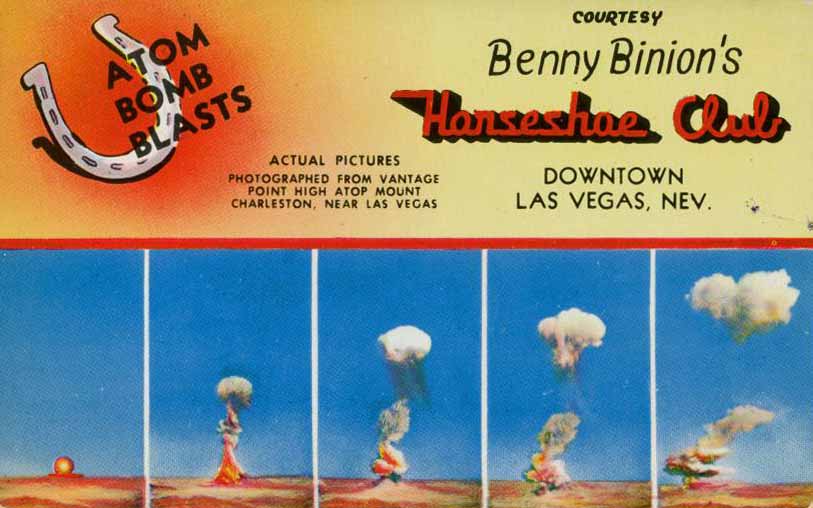
A Horseshoe Club advertisement touting its excellent views of nuclear tests.
The nuclear detonations provided a source of spectacles and entertainment for people who did live in this area. As a result, Vegas began to experience a new influx of people from across the country who would travel thousands of miles in order to catch a glimpse of this new show.
Soon after Las Vegas was transformed from the original city of 25,000 people to the world-renown spectacle of three million people.
Journalists everywhere began jumping on this new exciting event, and the topic of atomic tourism became the biggest headliner everywhere.
Even writers in the New York Times began referring to it as, “the non- ancient but nonetheless honorable pastime of atom-bomb watching.”

Witness the power of the Atomic Bomb. A mere $3 for a safe viewing distance.
Inherently speaking, Vegas was designed for showmanship. Visitors are encouraged to live in the moment and focus on what is in front of them, by masking the individual from all reminders of time and location.
Their motto: pay attention to what is in front of you. Therefore by taking advantage of this concept and its psychological effect, landowners and industry owners began turning these tests into spectacles of themselves.
The Vegas Chamber of Commerce promoted in advance the dates and times for these tests. Calendars and community announcements would be published months in advance for tourists to plan and enjoy the spectacle of the mushroom cloud.
Photos of these events began circulating across news sources everywhere and bomb-watching became such a rage that thrill-seeking tourists would make sure to get the closest spot possible to the ground-zero.
On the eve of detonations, many Las Vegas businesses held “Dawn Bomb Parties.” Beginning at midnight, guests would drink and sing until the flash of the bomb lit up the night sky.

Bombs over Fremont.
However, in addition to these parties, Vegas also capitalized on the nuclear tests by providing itself as a source of relief and nostalgia from the surrounding terror.
Gambling, games, and television were all sources of distraction that provided Vegas guests with an escape from the fear that was surrounding them.
Both Vegas itself and the Yucca Flats of the Nevada Testing Site were turned into tourist attractions of various sorts. The main spectacle of the site to date are the large craters currently scarring the desert surface.
The desert floor is sprinkled with craters of all shapes and sizes, ranging from nuclear warheads to smaller surface-level bombs.
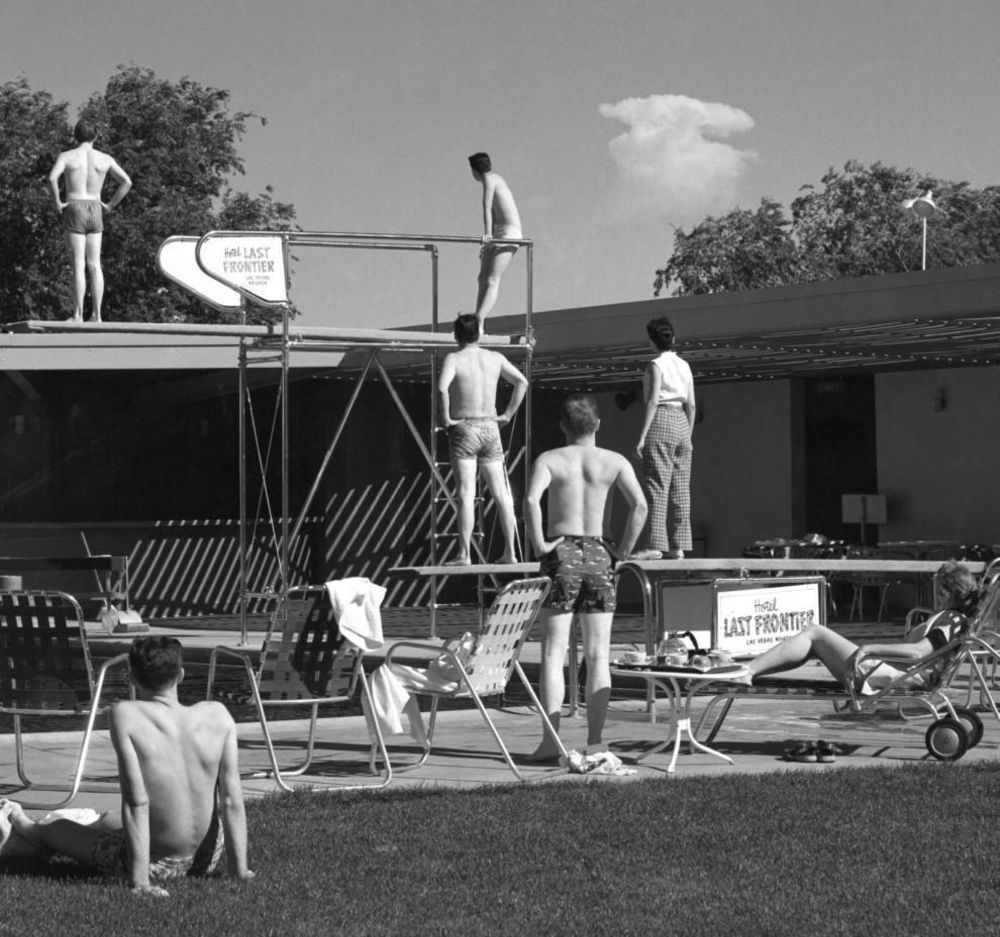
Early morning bathers at a hotel pool in Las Vegas stop to watch the mushroom cloud of an atomic detonation at a test site about 75 miles from the city. May 8, 1953.
One of the more popular craters is Bilby crater, which was created in 1963 by an underground test. Producing about 249 kilotons of explosive power, the blast created a hole that was 1,800 feet wide (550m) and 80 feet (24m) deep and also resulted in an aftershock that was felt all the way in Vegas itself.
Sedan crater is also popular due to its large size. Sitting at about 1280 feet (1280m) wide and 230 feet (70m) deep, a 104 kiloton blast right beneath the surface of the desert floor produced this crater.
The effects compared to that of a 4.75 earthquake moved about 12 million tons of Earth in its passing.
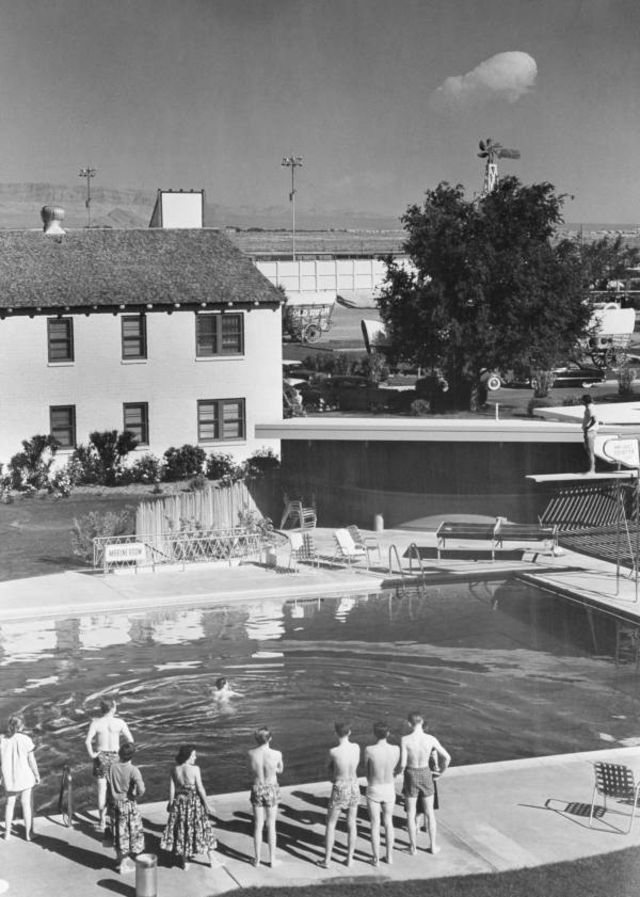
Guests at the Last Frontier hotel in Las Vegas watch the mushroom from a detonation about 75 miles away. May 8, 1953.
One journalist, writing for the Department of State Washington Bulletin, described witnessing the blast: “You put on the dark goggles, turn your head, and wait for the signal. Now — the bomb has been dropped. You wait the prescribed time, then turn your head and look.
A fantastically bright cloud is climbing upward like a huge umbrella…. You brace yourself against the shock wave that follows an atomic explosion.
A heat wave comes first, then the shock, strong enough to knock an unprepared man down. Then, after what seems like hours, the man-made sunburst fades away.”
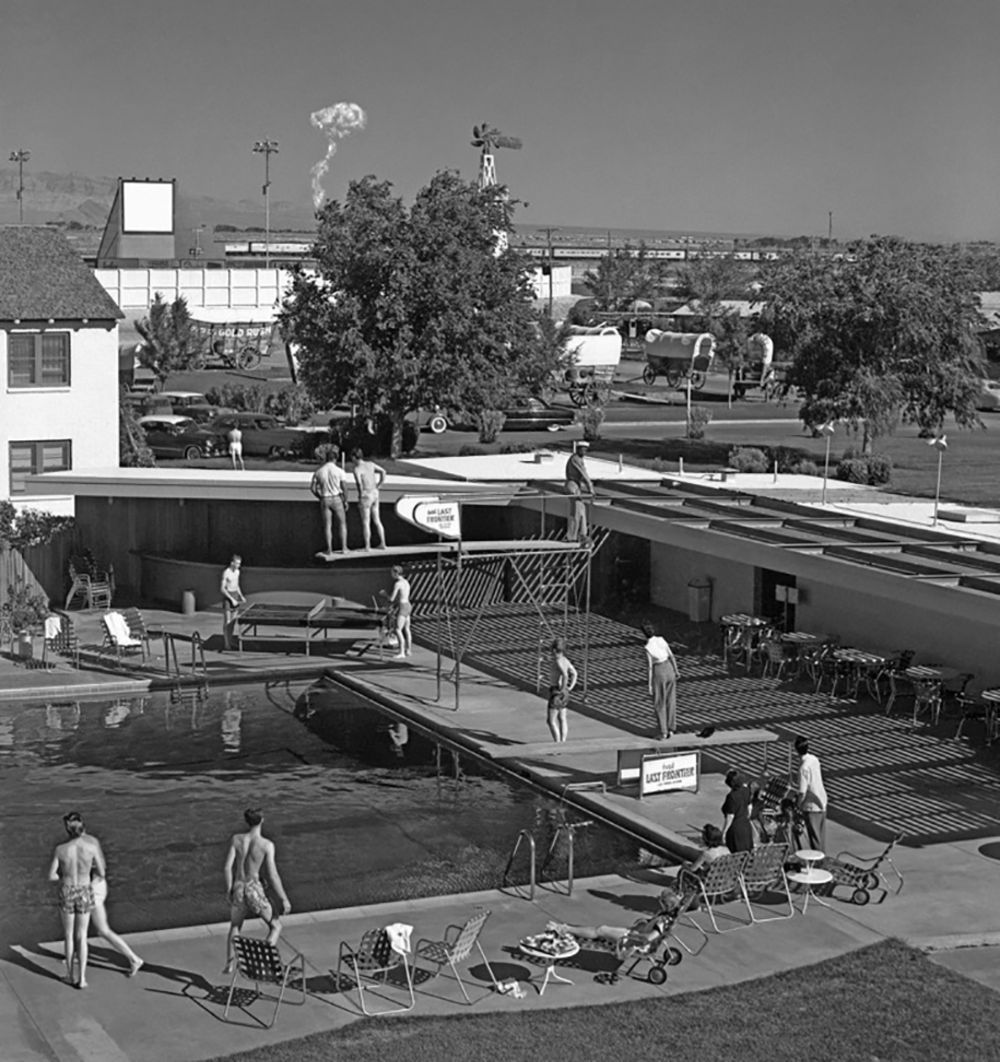
Watching poolside. Nuclear tests were a rather ordinary part of life in Las Vegas.
For twelve years, an average of one bomb every three weeks was detonated, at a total of 235 bombs. Flashes from the explosions were so powerful that they could reportedly be seen from as far away as Montana.
Scientists claimed that the radiation’s harmful effects would have dissipated and been harmless once the shock waves reached Las Vegas, and they scheduled tests to coincide with weather patterns that blew fallout away from the city.
However, as the tests continued, people in northeastern Nevada and southern Utah began complaining that their pets and livestock were suffering from beta particle burns and other ailments; by 1963 the Limited Test Ban was in effect, banning above-ground nuclear testing at the site.
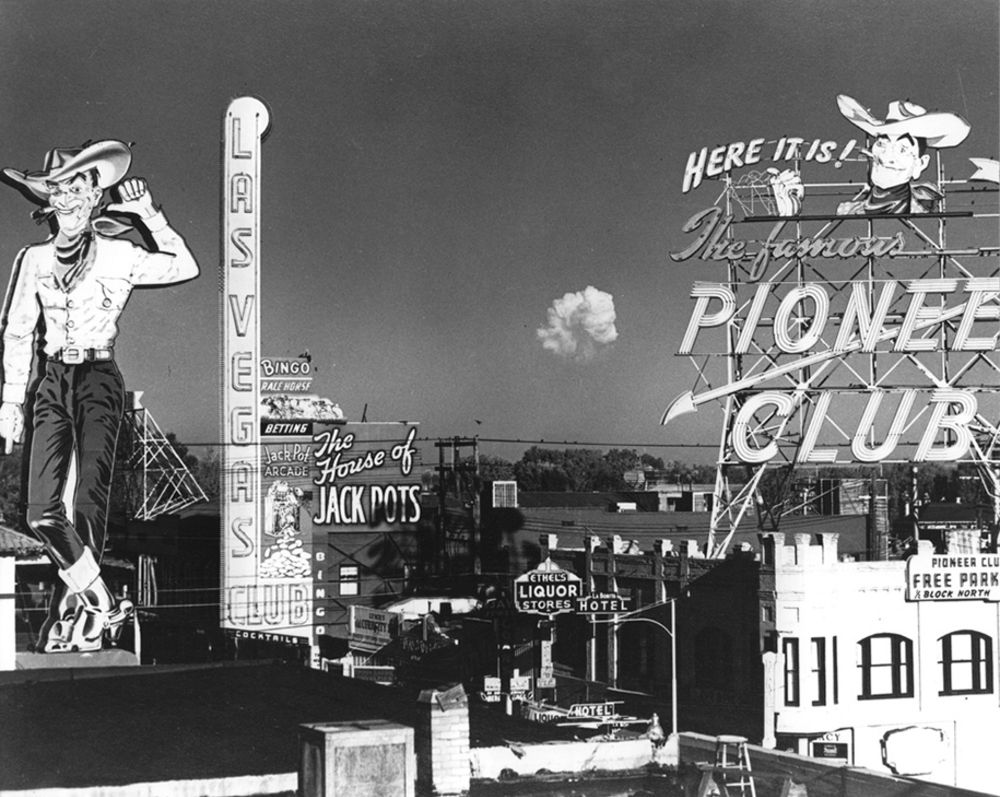
Hotels offered panoramic views of the distant desert skyline for the optimum experience.
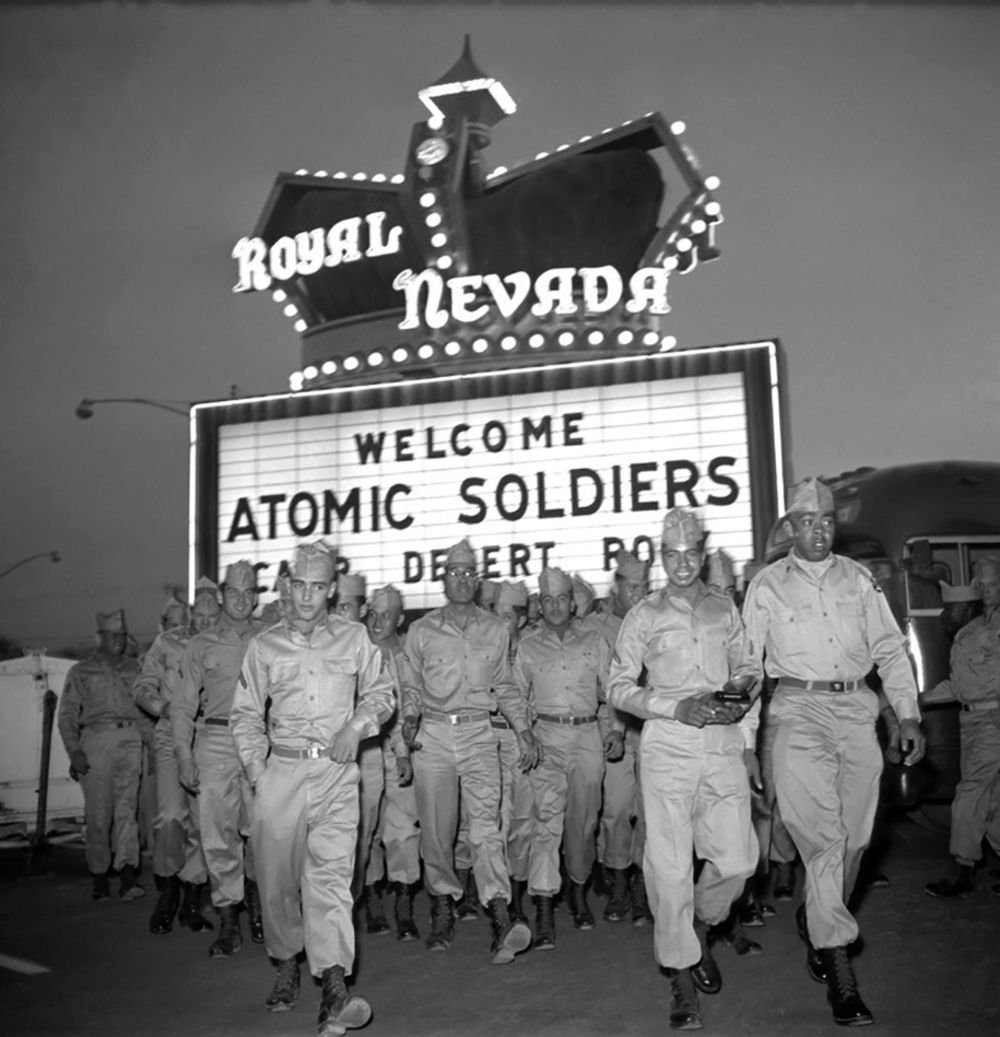
The Nevada Test Site wasn’t just a boom for travelers. The proving ground flooded the area with federal funds, and the site employed close to 100,000 men and women.
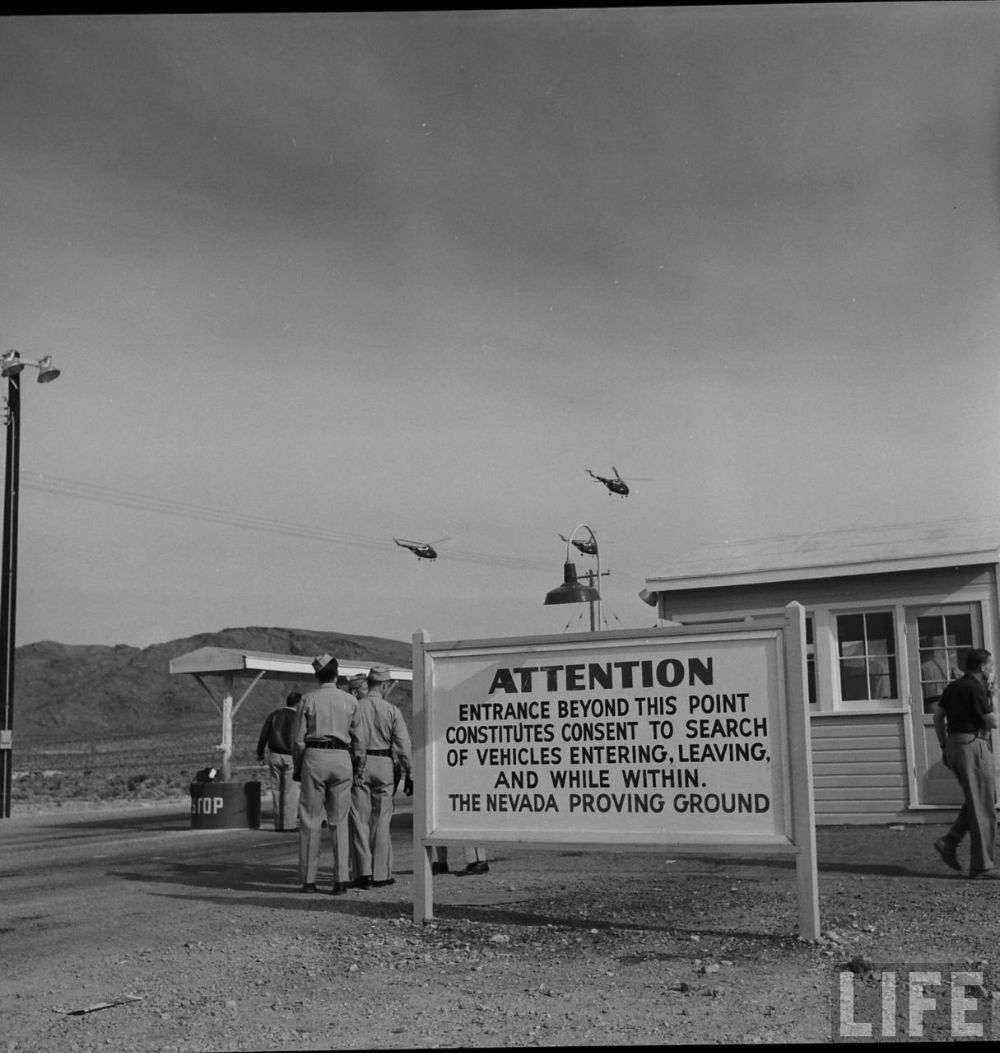
Nevada test site.
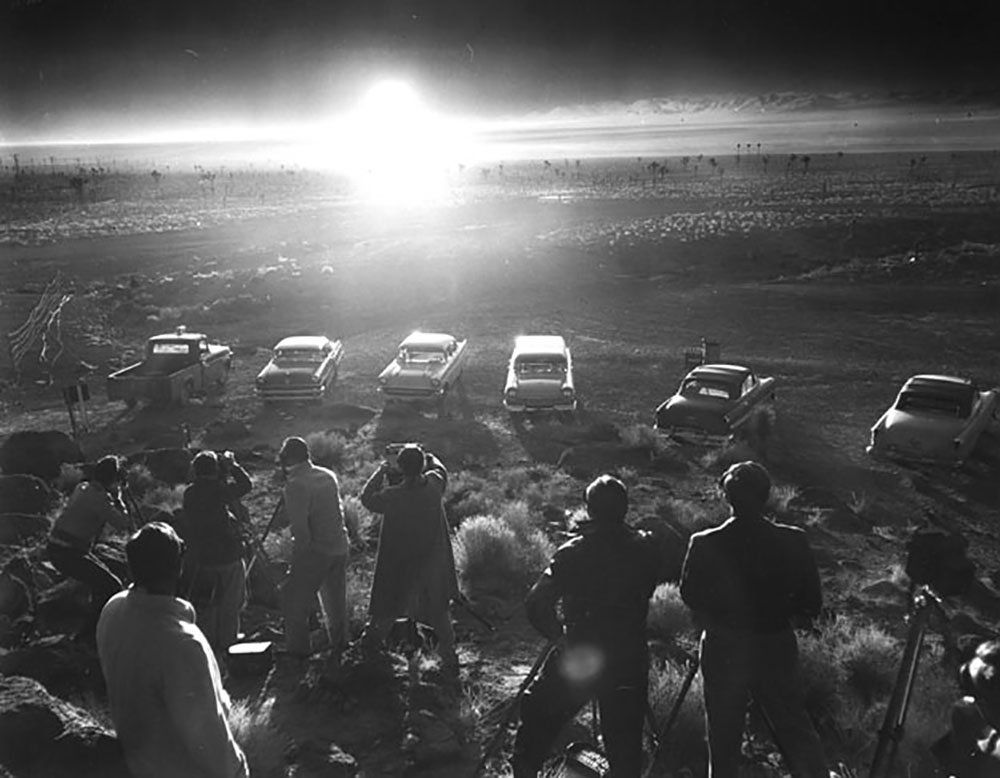
Reporters witness the nuclear test on Frenchman Flat, on June 24, 1957.
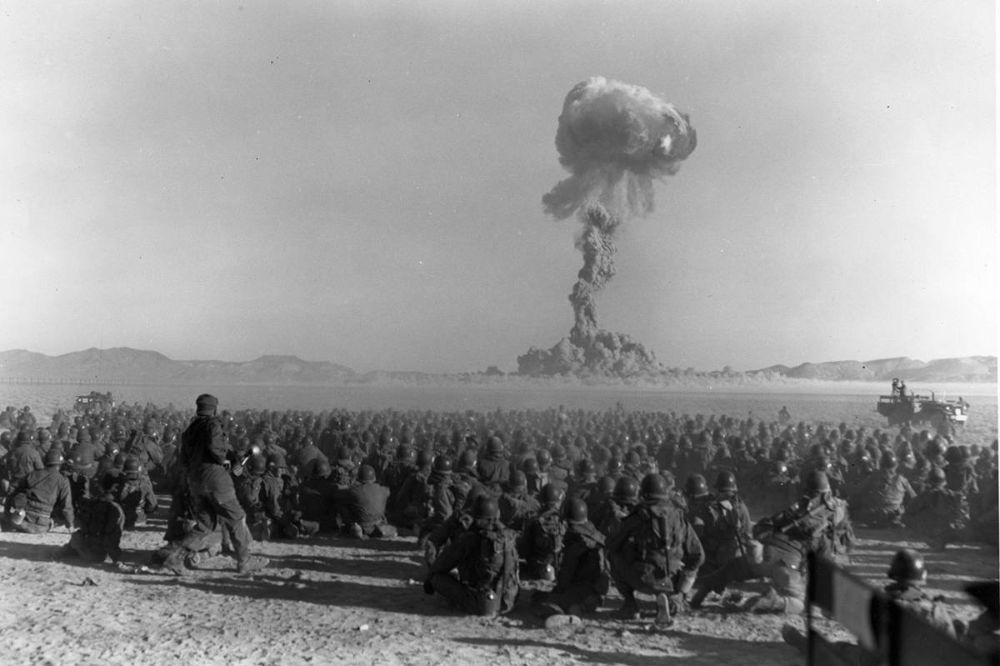
Operation Buster-Jangle – Dog test — with troops participating in exercise Desert Rock I, November 1, 1951. It was the first U.S. nuclear field exercise conducted on land; troops shown are a mere 6 miles from the blast.

Atomic tourists taking in the sites.
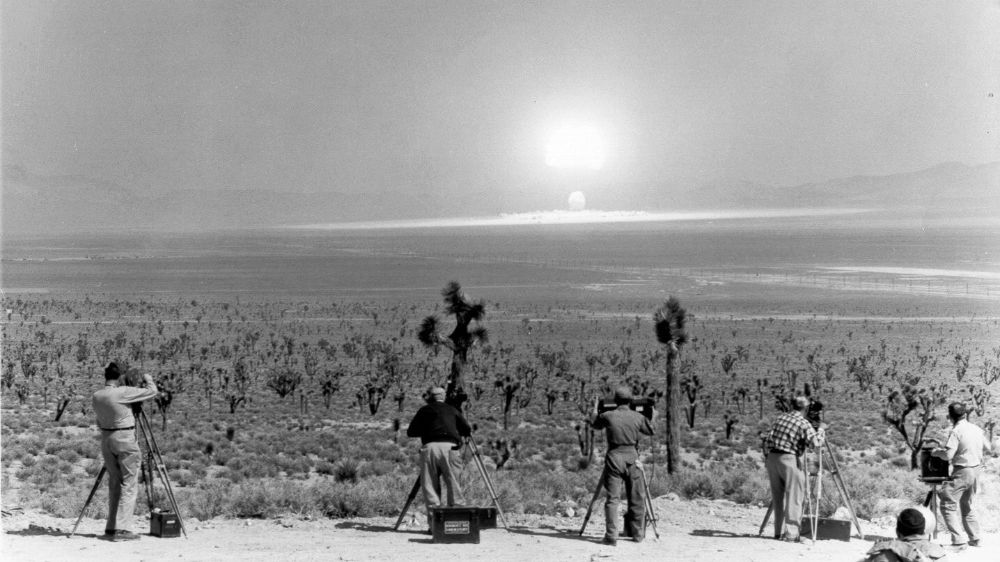
Camera men filming the atomic blast of Wasp Prime Test, during Operation Teapot. Nevada, February 18, 1955.
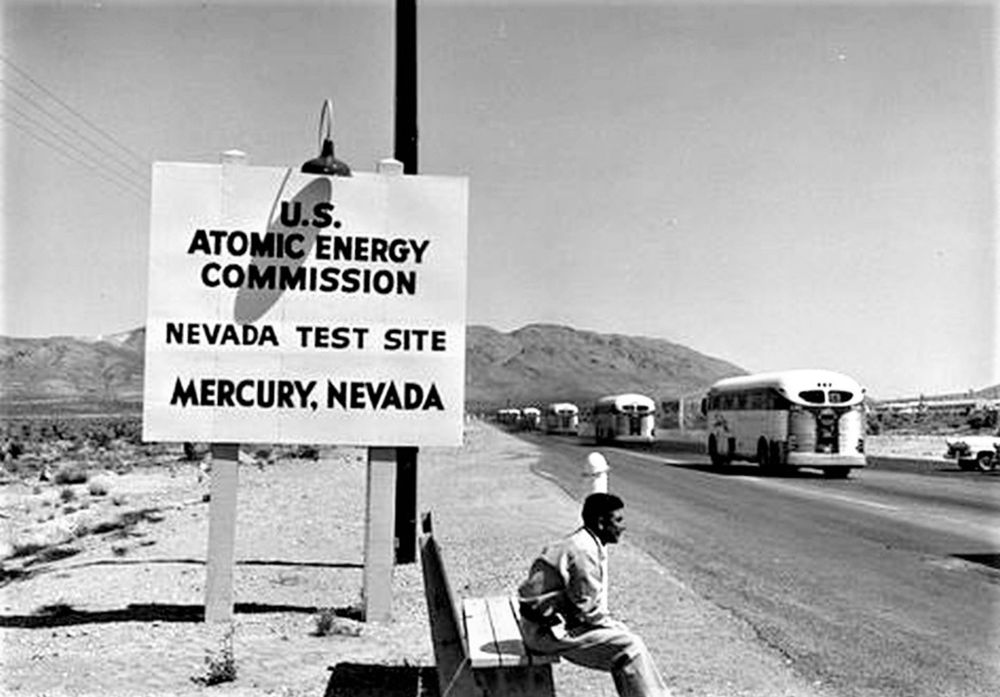
Man sitting near a Nevada Test Site sign, Nevada, United States, 1955 From 1951–1962, Mercury was a town in the Nevada atomic testing site where hundreds of test explosions were conducted.

Watching poolside.

Soldiers at the test site.

Fashion of the atomic age.

The first flash of light generated by an atomic bomb.

Birds-eye view of dozens of craters dotting the Yucca Flats.

A nuclear crater left behind.

Model posing in front of a nuclear cloud.

Miss Atomic Bomb of Sin City.

Photograph of Yucca Flat, covered with craters created by atomic bombs, in the Nevada Test Site.
(Photo credit: Wikimedia Commons / Las Vegas News Bureau / US Army Archives / Atomic Tourism in Las Vegas by Kiana Pancino).
Updated on: September 29, 2022
Any factual error or typo? Let us know.
- Chernobyl Victims
- The Chernobyl Exclusion Zone
- The Abandoned City of Pripyat
- The Chernobyl Nuclear Power Plant
National Geographic Magazine Publishes “The Nuclear Tourist”
September 24, 2014
NATIONAL GEOGRAPHIC MAGAZINE PUBLISHES “THE NUCLEAR TOURIST” SEPTEMBER // 2014
After the publication of his 20-year retrospective “The Long Shadow of Chernobyl†Gerd Ludwig continues to explore the aftermath of the world’s worst nuclear disaster to date. In a story titled “THE NUCLEAR TOURIST,†the October issue of National Geographic Magazine USA and several of the foreign language editions of NG published Gerd’s images of tourism in the Chernobyl Exclusion Zone (text by George Johnson). For more information and to see the images: Click here
In addition, the German language edition of National Geographic ran a 2-page interview with Gerd about the power of photography and what makes working for National Geographic special. To read the interview: Click here
To order a signed copy of the book: Click here
Comments on this entry are closed.
Previous post: Chernobyl Museum & Meeting with Klitschko
Next post: THE LONG SHADOW OF CHERNOBYL NAMED THE POYi PHOTO BOOK OF THE YEAR
The Long Shadow of Chernobyl Photo Book Now Available
Sponsorship supports The Photo Society
Gerd Ludwig Photography Institute for Artist Management Kickstarter Page Facebook Page Twitter Instagram Edition Lammerhuber Lightbox Press
Powered by Wordpress and the Thesis WordPress Theme from DIYthemes.
© Gerd Ludwig 2014. All Rights Reserved. Contact Us
Multilingual WordPress by ICanLocalize
Nuclear tourism

- 1 Get ready
- 2.1 Bombed cities
- 2.2 Weapon test sites
- 2.3 Peaceful use of nuclear explosions
- 3.1 Accidents in nuclear power plants or nuclear materials production sites
- 3.2 Accidents of nuclear weapon carrying aircraft
- 4 Manhattan Project-related sites
- 5 Atomic museums
- 6.1 Operating reactors
- 6.2 Decommissioned reactors
- 7.1 Nuclear power plant building sites never finished
- 7.2 Sites related to German nuclear bomb project
- 7.3 Nuclear bunkers
- 7.4 Nuclear weapon sites
- 7.5 Nuclear waste related sites
- 7.6 Non-categorized
- 8 Stay safe

Nuclear tourism is travel to places connected with nuclear history, nuclear science, and nuclear technology. This can include historical sites of nuclear detonations or places related to peaceful or wartime use of nuclear energy.
Sites of interest to the nuclear tourist may include:
- Sites of nuclear detonations (bombed cities, nuclear weapons tests, sites related to peaceful uses of nuclear explosives).
- Sites of nuclear accidents and accidents of aircraft carrying nuclear weapons.
- Museums of nuclear history, nuclear science, or nuclear technology.
- Former nuclear missile silos and nuclear fallout shelters.
- Other sites relating to nuclear history, nuclear science, and nuclear technology (for example, nuclear particle accelerators and sites of nuclear physics research).
Get ready [ edit ]
See Golden Age of Modern Physics for the discoveries that led up to the atomic age.

Although in many of the nuclear tourism sites only background radiation can be detected, in some other visitors are confronted with higher levels. These include mainly sites related to nuclear accidents and weapons testing. When visiting places with increased radiation, it is reasonable to be equipped with a radiation monitor in order to have control over radiation exposure. The most common devices in a reasonable price range usually contain a Geiger-Müller counter. They are suitable for detection of gamma, x-ray, alpha and beta radiation, typically expressed as counts per second. In other devices the registered gamma radiation is converted in units of dose rate or absorbed dose. These basic counters can not provide information about individual isotopes, natural or man-made, but simply sum up all registered radiation.
In order to be able to use the radiation monitor it is essential to get familiar with the units and ranges of the measured values to evaluate the information obtained from the counter. Additionally, one has to be aware of a strong variation of natural background radiation, which depends mainly on local geology.
Sites of nuclear explosions [ edit ]
Bombed cities [ edit ].

34.395 132.455 1 Hiroshima , Japan, was a target of the first nuclear attack ever on 6 August 1945. Nowadays the event with 90,000–166,000 civilian victims is commemorated at the Atomic Bomb Memorial Museum and in Peace Memorial Park, including the iconic A-Bomb Dome and Children's Peace Monument covered by colorful paper cranes for bomb victim, Sadako Sasaki. Ground Zero is slightly outside of the park not far from the Atomic Bomb Dome.
Another nuclear bomb was dropped three days later on the industrial town of 32.773 129.864 2 Nagasaki , Japan, with more than 100,000 victims. Visitors can learn about the tragic piece of history in the Nagasaki Atomic Bomb Museum or the Nagasaki National Peace Memorial Hall for the Atomic Bomb Victims, both near ground zero.
The aircraft that dropped nuclear weapons on Japanese civilians are in US museums. Enola Gay (the plane which bombed Hiroshima) is displayed at the Udvar-Hazy Center (part of Smithsonian's National Air and Space Museum) in Chantilly , Virginia ; Bockscar (which bombed Nagasaki) is on display at the U.S. Air Force Museum near Dayton , Ohio.
See the Pacific War article for the events leading up to the bombs.
Weapon test sites [ edit ]

Eight countries have carried out confirmed nuclear weapon tests to determine the capability of their weapons, mostly in their own respective territories. The United States conducted the first and the most numerous tests, mostly in Nevada . Others carrying out tests included Russia (then the Soviet Union ), the UK, India, France, and China. Pakistan, followed by North Korea, conducted the last nuclear weapon tests. Sites where weapon tests were conducted can be visited in these countries for adventure.
- 50.12 78.72 5 Semipalatinsk test site . can be visited from city of Semey by own means (taxi). The National Nuclear Center in nearby Kurchatov organizes official tours to the test area.
- Atolls 11.6981 165.2731 6 Bikini and 11.552565 162.347241 7 Enewetak are former US test sites at Marshall Islands . They are in the middle of the Pacific, far away from any mainland, so they are difficult to visit. Bikini Atoll is open for tourism from late April to November and welcomes divers participating in organized tours . These tours that start at Kwajalein Atoll are only available to experienced divers and the main attraction is the U.S. fleet sunk by the nuclear tests at Bikini. In the 1970s the U.S. Army performed a clean-up of contamination at Enewetak. As a result, radioactive materials from Enewetak and other contaminated atolls were dumped into the Cactus test crater at a tiny island Runit within the Enewetak Atoll and covered by a concrete structure, known as Cactus dome.
Peaceful use of nuclear explosions [ edit ]
In the USA, 27 peaceful nuclear explosions were conducted within Operation Plowshare to test the use of nuclear explosions for various civilian purposes, such as excavating channels or harbors and stimulating natural gas production from sediment layers. Most of the shots were performed at the Nevada test site; however, some of the test sites in Colorado and New Mexico are accessible for the public.
- 39.793 -107.948528 14 Rio Blanco test site ( 50 mi NW of Rifle , USA, the last couple of miles via unpaved Rio Blanco County Route 29, but still easily accessible for non-4x4 vehicles ). This was the final test in the Plowshare program, with three devices being detonated underground in order to stimulate natural gas production in 1973. While the production increased slightly, the gas was too radioactive to be used. A small monument was erected at the surface ground zero. ( updated Aug 2015 )
Sites of nuclear accidents [ edit ]
Some might find it unethical or at least controversial for tourists to visit sites where many people suffered following an accident, especially if local guides are repeatedly exposed to radiation when leading tour groups through exclusion zones too "hot" for residents to return.
Conversely, some welcome tourism as an alternative means to support local economies.
Accidents in nuclear power plants or nuclear materials production sites [ edit ]

- 54.4205 -3.4975 16 Sellafield , United Kingdom, has been the site of a number of accidents, including the 1957 fire of the original Windscale former nuclear reactor. During those accidents some radioactive waste ended up in the Irish Sea, near Whitehaven . Also, during the reactor fire radioactivity was released through the chimney. However the major portion was contained by the high-capacity filters mounted on the chimney (known as "Cockcroft's Folly" after the Nobel prize winning physicist Sir John Cockcroft, who insisted on having them mounted at great expense, although they hadn't been included in the original design. Their shape contributed to the iconic silhouette of the nuclear complex. However, in 2014 the second of two chimneys was decommissioned and is no longer part of the Sellafield skyline.)
- 40.15269 -76.717409 17 Three Mile Island , near Harrisburg , Pennsylvania , USA, was the worst commercial nuclear power plant accident in the USA on 28 March 1979. During the reactor core meltdown, radioactivity, mainly in the form of radioiodine and noble gases, was released to the surrounding environment. There is no visitors' center commemorating the event, only a historic marker (at the given coordinates in Middletown ) with a fine view across the Susquehanna river towards the power station.
- 37.4214 141.0325 18 Fukushima Daiichi nuclear power plant in Japan was seriously damaged by a tsunami following a magnitude 9 earthquake on March 11, 2011. Large areas of Fukushima prefecture coast are being decontaminated, while some 80,000 inhabitants had to be resettled. Tours are offered to the visitors to get first-hand impressions from areas affected by the great Tohoku earthquake, tsunami, and nuclear accident. The participants can experience how local people and businesses are coping with the recovery from the disasters.
Accidents of nuclear weapon carrying aircraft [ edit ]
During the Cold War there were several accidents involving thermonuclear weapons, and some of them led to local environment contamination. These are a few of them.
- In 35.493041 -77.859262 19 Faro near Goldsboro (North Carolina) , USA, a B-52 crash dropped a hydrogen bomb which failed to detonate in 1961. The event is commemorated by a historical road marker in the town of Eureka, 3 miles (4.8 km) north of the crash site.
- A 34.205556 -79.655278 20 crater about 23 m wide and 11 m deep was left after another accident, in which a B-47 "Stratojet" crew mistakenly released a Mark 6 bomb while flying over Mars Bluff , South Carolina , USA, on March 11, 1958 afternoon. The bomb went off by a conventional explosion at the property of local family Gregg and injured several family members. The crater can be visited from SC Highway 76 (East Palmetto Street) via a marked trail. There is an informational board and mock up of the bomb's size at the site. Nearby 34.19563 -79.76632 21 museum in Florence has the story to tell including some historical artifacts connected to the event.
- In 1966 after an unsuccessful inflight refueling operation an US bomber B-52 carrying four hydrogen bombs crashed in 37.247 -1.797 22 Palomares between Almería and Cartagena , Spain. Now, after cleanup operations, the area is used extensively for agricultural production. Two of the "hot areas" are closed to the public by a fence.
- Another accident occurred in 1968, when B-52 "Stratofortress" with four hydrogen bombs on board crashed onto the sea ice near the 76.527778 -69.281944 23 Thule Air Base , Greenland. The nearest civilian settlement is Qaanaaq , 100 km to the north.
Manhattan Project-related sites [ edit ]
"Manhattan Project", named for the Manhattan Engineering District of the US Army Corps of Engineers, is a cover name for a war-time US military effort to develop an atomic weapon. Geographically, the project was spread over about 30 sites across the United States (and Canada). The best known are the secret laboratory in Los Alamos and factories to supply the fissile materials by enriching uranium and producing plutonium in reactors in Oak Ridge , Tennessee, and Hanford site near Richland , Washington. These three sites are also formally recognized as Manhattan Project National Historical Park .
Atomic museums [ edit ]

- 43.51132 -113.0064 36 Experimental Breeder Reactor I , Arco , Idaho, USA - the first nuclear reactor to produce electrical power, first breeder reactor, and first reactor to use plutonium as fuel
- 31.902663 -110.999576 38 Titan Missile Museum , 1580 W Duval Mine Rd, Sahuarita, Green Valley , Arizona, USA ( 30 minutes south of Tucson ), ☏ +1 520-625-7736 . Daily 8:45AM-5PM . Site south of Tucson preserves a Cold-War-era underground silo housing an unarmed Titan-II ICBM, the only remaining Titan Missile silo in the US. Part of a larger field of such silos, this was one of the places from which nuclear war on the Soviet Union would have been waged. Visitors can take a tour of the underground facilities where USAF crews spent decades living underground waiting for the launch order which never came. $9.50 (adults) .
Research reactors [ edit ]
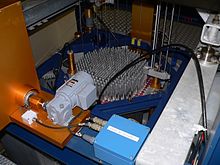
Several sites operate nuclear reactors for either nuclear reactor safety training or for nuclear science experiments using them as neutron sources. Neutron scattering is an effective ways to obtain information on the structure and the dynamics of condensed matter. These days accelerators like the Spallation Neutron Source based in Oakridge allow more intense neutron beams. Nevertheless several reactors are in on-going operations. Fundamental and solid state physics, chemistry, materials science, biology, medicine and environmental science pose scientific questions that are investigated with neutrons.
In contrast to nuclear fission, where unstable atoms decay into smaller atoms, there exists also an attempt of nuclear fusion, where energy would be gained by processes similarly to what happens in the core of stars by the fusion of two light elements in a heavier one. ITER is an international nuclear research and engineering project to build the first the world's largest experimental tokamak nuclear fusion reactor.
Operating reactors [ edit ]
- 46.52 6.565 39 [dead link] CROCUS , École polytechnique fédérale de Lausanne (EPFL), Switzerland . A light-water, zero-power nuclear reactor for research and teaching at the Swiss Federal Institute of Technology in Lausanne.
- 48.266 11.676 40 Forschungsreaktor München II ( FRM II ), Lichtenbergstraße 1, Garching bei München, Germany ( U6 to Garching-Forschungszentrum ), ☏ +49 89 289 12147 , [email protected] . The reactor is an optimised neutron source. Almost 50% of experiments are performed using cold neutrons. The compact construction of the fuel element means that more than 70% of the neutrons leave the uranium zone and build up to a maximum thermal neutron flux density at a distance of 12cm from the surface of the fuel element. From where they are distributed to the experiments. Please register early in advance your visit either by email or phone. The visitor needs to be older than 16 years, not pregnant and no phones or cameras are allowed inside.
- 48.197003 16.412999 41 Institute of Atomic and Subatomic Physics ( Atominstitut ), Stadionallee 2, Vienna, Austria ( Vienna/Inner East ), ☏ +43 1 588 01 141391 , [email protected] . The 250 kW TRIGA Mark II reactor in the Viennese Prater started operation in 1962. The reactor is a training ground for International Atomic Energy Agency (IAEA) inspectors and neighbouring countries. The Atominstitut offers guided tours for groups upon previous registration. €4/person . ( updated Apr 2015 )
- 43.704956 5.769194 42 ITER ( International Thermonuclear Experimental Reactor or "the way" (Latin) ), Route de Vinon-sur-Verdon, St. Paul-lez-Durance, France ( CPA bus line 150 ( Aix-en-Provence --St Paul lez Durance) ), ☏ +33 4 42 17 66 25 , [email protected] . The ITER project aims to make the transition from experimental studies of plasma physics to an electricity-producing fusion power plants. ITER is designed to produce 500 megawatts of output power. Visitors are welcome year round on the first Friday of every month at the ITER site. General public visits include a stop at the Visitor's Centre for a presentation of the project followed by guided tour of the ITER platform where the ITER scientific facilities are under construction. Visit requests should be made at least four weeks in advance via on-line tool. Free of charge, groups larger than 8 must book a bus . ( updated Apr 2015 )
- 54.07295 13.425 43 Wendelstein 7-X fusion device ( Max-Planck-Institut für Plasmaphysik ), Wendelsteinstraße 1, Greifswald , Germany , ☏ +49 3834 88-1203 , +49 3834 88-1800 , [email protected] . In Greifswald the large Wendelstein 7-X fusion reactor (stellarator) is under construction. The device as well as technology and workshops can be toured upon previous booking.
- 52.41 13.129444 44 Helmholtz-Zentrum Berlin, Germany . The 10 MW research reactor BER II delivers neutron beams for a wide range of scientific investigations. On open house day, interested visitors are allowed to take guided tours through the experimental halls around the research reactor. Scientists and reactor experts will be there on these days to answer questions about the facility and the safety measures.
- 47.538554 8.229899 45 Swiss Spallation Neutron Source ( SINQ ), Paul Scherrer Institut bldg. WHGA/147, Villigen PSI, Switzerland ( about 10 km north of Brugg ). SINQ is designed as a neutron source mainly for research with extracted beams of thermal and cold neutrons, but hosts also facilities for isotope production and neutron activation analysis.
- 33.640495 -117.844296 46 TRIGA Mark I ( at the University of California, Irvine, in Irvine, California , USA ). The original prototype for the TRIGA (Training Research Isotopes General Atomic) reactor, one of the safest reactor designs. 66 such reactors are or have been operational worldwide, mostly at universities for educational use. The reactor has been declared a nuclear historical landmark. ( updated Aug 2015 )
- 55.796111 37.478611 47 [dead link] F-1 ( Kurchatov Institute, Moscow, Russia ). The first functioning nuclear reactor in Europe (Dec 1946) is still running. ( updated Aug 2015 )

Decommissioned reactors [ edit ]
- 55.604564 26.560546 49 The Ignalina Nuclear Power Plant ( IAE ) ( in Visaginas municipality, Lithuania ). It had two reactors - the first one was in operation from 1983 and was decommissioned in 2004, the second from 1987 until 2009. INPP will be fully dismantled in 2038. INPP offero excursions to its controlled INPP zone, home to the plant’s reactor room, turbine room, and block control panel. These excursions have become popular following the broadcast of the HBO miniseries Chernobyl , much of which was filmed on the site of the first reactor at INPP. ( updated Jun 2019 )
Other [ edit ]
Nuclear power plant building sites never finished [ edit ].
Some nuclear power plants never had a nuclear fission reaction happening on their site, as they were not turned on.

- Ruins of the 45.3914 35.8023 54 Crimean Atomic Energy Station , Russia
Sites related to German nuclear bomb project [ edit ]
Germany, which had had some leading nuclear scientists before the war (some of whom fled the country after the Nazi takeover due to being Jewish, opposed to the regime or both), developed a much more modest and less advanced nuclear program than the Allies. It received less funding and was hampered by Nazi ideology which rejected some of Albert Einstein's findings as "Jewish Physics", but its speculated existence during the war was one of the driving factors for the Manhattan project.
- 59.871111 8.491389 57 Vemork , Norway . : Heavy water production site and location of war-time heavy water sabotage. Heavy water is an important component in certain nuclear applications and was seen as critically necessary for the development of a nuclear bomb during World War II. Despite the German occupation of Norway, Norwegian underground fighters ultimately managed to keep the heavy water out of the hand of the Nazis, thereby delaying the nuclear program of Nazi Germany which failed.
Nuclear bunkers [ edit ]
Nuclear bunkers were meant to protect in the case of nuclear weapon explosions. During the cold war this threat was considered imminent, hence many key figures would need access to such bunkers. While nothing was likely to withstand a direct hit, bunkers were built far underground to survive a nuclear strike which landed as close as 1 mile (1.6 km) away.
Fallout shelters were intended to shelter populations in areas far from the targets of a nuclear strike; these communities were likely to be spared direct blast damage but still become dangerously radioactive in the initial days or weeks after an attack. Often, civil defence authorities would make provision for a posted fallout shelter in the basement of a library, post office, school or other large public building. In some countries building regulations even pushed for bunkers in the cellars of small domestic buildings.
Nuclear weapon sites [ edit ]
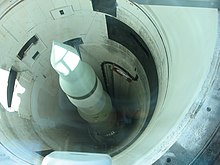
Nuclear waste related sites [ edit ]
Nuclear waste is a big headache in all nuclear applications as it remains dangerous for timespans humans cannot generally oversee. There are various philosophies as to what to do with the waste, including putting it into abandoned salt mines as salt has high stability to waste heat (nuclear waste produces a lot of heat) and salt tends to naturally seal cavities. However, salt is vulnerable to water entering and there is the danger of that water connecting to groundwater, as has happened at several salt mines.
Non-categorized [ edit ]
- 53.55903 10.01975 75 A Memorial to the X-ray martyrs of the world in Hamburg , Germany ( Ehrenmal der Radiologie ) ( Garden of St. Georg hospital ). This monument is devoted to researchers, physicians, physicists, radiographers, laboratory technicians and nurses who died from injuries or illnesses caused by prolonged exposure to radiation used in medicine. On the list of about 360 names of radiologists from 23 countries perhaps the best known are Marie Sklodowska-Curie and her daughter Irène Joliot-Curie.
Stay safe [ edit ]

One obvious concern in touring nuclear sites is radiation . In fact, good news is that most of the sites listed above are safe from this point of view. Where obvious danger exists, you should be usually stopped by fence and other security measures.
In case you happen to find yourself in a less safe situation or unknown suspicious area, you will hopefully be equipped with a radiation monitor and good knowledge of how to use it. It's important to know how to interpret the readings and/or convert the units. Although officially there is nothing like a safe level or radiation, there are some levels that can help to put the numbers into context. These are some examples:
- The typical yearly dose from purely natural background, consisting mainly of radon gas we breathe, building materials surrounding us, radionuclides in food we eat and from the cosmic radiation that keeps bombarding us. This value is 2.4 thousandths of Sievert (mSv) on average, with a large range between 1–13 mSv depending mainly on the geological background of the place you live.
- Additionally to natural sources, artificial radiation contributes to radiation exposure of some of us. The main contributor here is medical diagnosis and treatment using radiation or radionuclides. Here the exposition varies widely based on number and type of such measures. Globally, an average person receives 0.6 mSv/yr, while in countries with well developed medical systems the numbers are higher, for example 3.14 mSv in the USA, which relies heavily on testing like CT scans and X-rays. One bone scintigraphy scan with the use of medial isotope Tc-99m results in a one-time dose of about 5 mSv. A chest CT scan can give a dose of 5–10 mSv, which is much higher than a simple chest x-ray of 0.2 mSv.
- Members of flight crews receive some 1.5 mSv annual dose due to increased cosmic radiation in high altitudes.
- The limit for members of the public in the Fukushima exclusion zone was set as 20 mSv/yr.
- Occupational limits for radiation workers are usually at 50 mSv/yr.
The way to protect yourself against external radiation exposure (like radiation coming from soil polluted with radioactive fallout) is to limit the time spent in the polluted area and keep your distance from the source (hot spots).
During your exploration you certainly want to avoid internal contamination , that means ingesting radionuclides by eating or drinking contaminated food, or inhaling radioactive particles. Some easy protective measures are therefore avoiding eating and drinking and wearing a respirator. If there may be radioactive dust or water, you also want to avoid carrying that out from the area in your clothes or hair. Be sure to get clean before touching any food or anything that you will regard clean.
Another kind of more general risks can arise from exploration of abandoned or off-limits urban locations. These include injuries or possible legal consequences. For more details check the Urbex article.
See also [ edit ]
- Cold War Europe
- Industrial tourism
- Mathematics tourism
- Military tourism
- Science tourism
- Spies and secrets
- Previous Featured travel topics
- Has custom banner
- Has mapframe
- Maps with non-default size
- Has map markers
- Listing without plain text name
- Articles with dead external links
- Has Geo parameter
- Articles with no Wikidata coords
- Historical travel
- Topic articles
- Guide topics
- Guide articles
- Pages with maps
Navigation menu
- American Nuclear Society
- The Canadian Nuclear FAQ by Dr. Jeremy Whitlock, reactor physicist for AECL
- FAQ about Nuclear Energy by Dr. John McCarthy of Stanford University
E-mail links for asking questions:
- Public Document Room or Office of Public Affairs , by US Nuclear Regulatory Commission
- Information , by Nuclear Energy Institute
- Public Outreach , by American Nuclear Society
If you e-mail questions, I cannot guarantee that I will be able to get back to you in a timely manner.
Copyright © 1996-2006. The Virtual Nuclear Tourist . All rights reserved. Revised: December 29,2005.

- Kindle Store
- Kindle eBooks
- Teen & Young Adult
Promotions apply when you purchase
These promotions will be applied to this item:
Some promotions may be combined; others are not eligible to be combined with other offers. For details, please see the Terms & Conditions associated with these promotions.
Buy for others
Buying and sending ebooks to others.
- Select quantity
- Buy and send eBooks
- Recipients can read on any device
These ebooks can only be redeemed by recipients in the US. Redemption links and eBooks cannot be resold.

Download the free Kindle app and start reading Kindle books instantly on your smartphone, tablet, or computer - no Kindle device required .
Read instantly on your browser with Kindle for Web.
Using your mobile phone camera - scan the code below and download the Kindle app.

Image Unavailable

- To view this video download Flash Player
The Nuclear Tourist Kindle Edition
- Print length 239 pages
- Language English
- Sticky notes On Kindle Scribe
- Publication date February 14, 2017
- Reading age 13 - 18 years
- File size 1159 KB
- Page Flip Enabled
- Word Wise Enabled
- Enhanced typesetting Enabled
- See all details
Product details
- ASIN : B06VVSSCL8
- Publication date : February 14, 2017
- Language : English
- File size : 1159 KB
- Text-to-Speech : Enabled
- Screen Reader : Supported
- Enhanced typesetting : Enabled
- X-Ray : Not Enabled
- Word Wise : Enabled
- Sticky notes : On Kindle Scribe
- Print length : 239 pages
- #4,089 in Teen & Young Adult Dystopian eBooks
- #19,131 in Dystopian Science Fiction (Kindle Store)
- #19,456 in Teen & Young Adult Science Fiction
Customer reviews
Customer Reviews, including Product Star Ratings help customers to learn more about the product and decide whether it is the right product for them.
To calculate the overall star rating and percentage breakdown by star, we don’t use a simple average. Instead, our system considers things like how recent a review is and if the reviewer bought the item on Amazon. It also analyzed reviews to verify trustworthiness.
- Sort reviews by Top reviews Most recent Top reviews
Top review from the United States
There was a problem filtering reviews right now. please try again later..
Top reviews from other countries
Report an issue
- Amazon Newsletter
- About Amazon
- Accessibility
- Sustainability
- Press Center
- Investor Relations
- Amazon Devices
- Amazon Science
- Sell on Amazon
- Sell apps on Amazon
- Supply to Amazon
- Protect & Build Your Brand
- Become an Affiliate
- Become a Delivery Driver
- Start a Package Delivery Business
- Advertise Your Products
- Self-Publish with Us
- Become an Amazon Hub Partner
- › See More Ways to Make Money
- Amazon Visa
- Amazon Store Card
- Amazon Secured Card
- Amazon Business Card
- Shop with Points
- Credit Card Marketplace
- Reload Your Balance
- Amazon Currency Converter
- Your Account
- Your Orders
- Shipping Rates & Policies
- Amazon Prime
- Returns & Replacements
- Manage Your Content and Devices
- Recalls and Product Safety Alerts
- Conditions of Use
- Privacy Notice
- Consumer Health Data Privacy Disclosure
- Your Ads Privacy Choices
Have an account?

The Nuclear Tourist
20 questions

Introducing new Paper mode
No student devices needed. Know more
What is the exclusion zone?
a vast, quarantined wilderness that surrounds Chernobyl
a military base camp
What are some characteristics that draw tourists to areas like Chernobyl?
the landscapes
outdoor activities
for the chilling results of a nuclear accident
What elements caused the explosion at Chernobyl in 1986?
an atomic bomb
a nuclear reactor overheated
a mixture of gases
What is the current condition of the towns of Pripyat and Chernobyl?
abandoned buildings, broken glass on the ground, and materials from the reactor's explosion
enormous industrial buildings
interesting amusement parks
Who is George Johnson?
Chernobyl's governor
a writer and journalist
Where is Chernobyl?
in the Soviet Union
Who are the "returness"?
stubborn old people, who insist on living in Chernobyl
tourists who want to come back
extreme tourists
How many villages were evacuated after the explosion?
Which is the approximate data about the people who were damaged with thyroid cancer for radiation exposure?
What other country suffered from a explosion in a nuclear plant?
Fukushima, Japan
Hiroshima and Nagasaki, Japan
Aushwitz, Germany
What is a type of literary nonfiction in which the writer describes what is like to visit a particular place?
Travel journalism
From the perspective of a reader, which are the results of an effective travel journalism article?
traveling tickets sales increasement
a vivid impression of a specific location or journey
personal tourist guides services
When does a writer give fact-based information in a travel journalism?
when he/she includes the place's location, how to get there, and key historical events
when he/she shares photographs in Instagram
when he/she shows the most popular hotels and resorts
When a writer includes what he/she saw, heard, felt, tasted, and smelled in a travel journal he/she is giving a __________.
personal observation
personal perspective
personal inferences
What are literary techniques in a travel journalism?
environmental issues
military issues
story-like sequence of events, figurative language, and dialogue
What is the main reason that so many buildings described in “The Nuclear Tourist,” such as the school and hospital, are crumbling and run-down?
No one has taken care of them for years.
Radiation in the area has damaged them.
Looters caused harm while removing valuable parts.
They were bulldozed soon after the nuclear accident.
The Latin root - spec means
The purpose of using scientific and technical terms in your writing is
There are three elements that are usually incorporated into travel journalism to effectively capture the readers interest and give a vivid impression of a specific location or journey. They are (check all that apply)
Fact-based information
Personal Observations
literary techniques
Explore all questions with a free account

Continue with email
Continue with phone
US-Saudi nuclear deal: how might it work?
- Medium Text
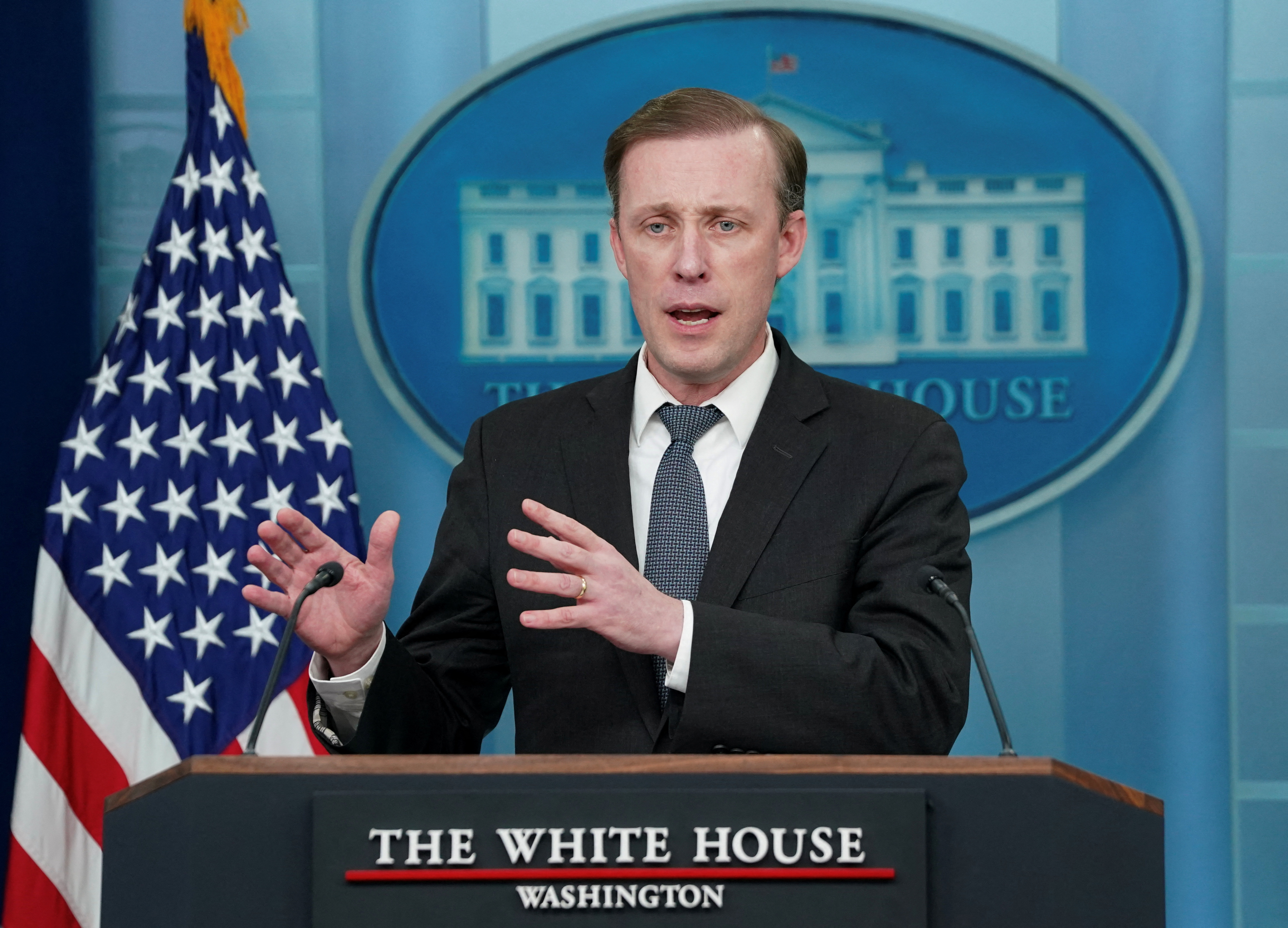
WHAT IS A CIVIL NUCLEAR COOPERATION AGREEMENT?
Why does saudi arabia want a us nuclear cooperation agreement, how would the united states benefit from a civil nuclear deal with saudi arabia, what are the hurdles to a us-saudi civil nuclear deal, what is the wider pact in which a nuclear deal might figure, what are some of the key issues to be worked out in a saudi-us nuclear deal.
Sign up here.
Reporting by Arshad Mohammed; Additional reporting by Timothy Gardner and Jonathan Landay Editing by Don Durfee, Jonathan Oatis and Lincoln Feast.
Our Standards: The Thomson Reuters Trust Principles. New Tab , opens new tab

World Chevron
Gazprom to send 42.4 mcm of gas to europe via ukraine on monday.
Russia's Gazprom said it would send 42.4 million cubic metres (mcm) of gas to Europe via Ukraine on Monday, a volume broadly in line with recent days.
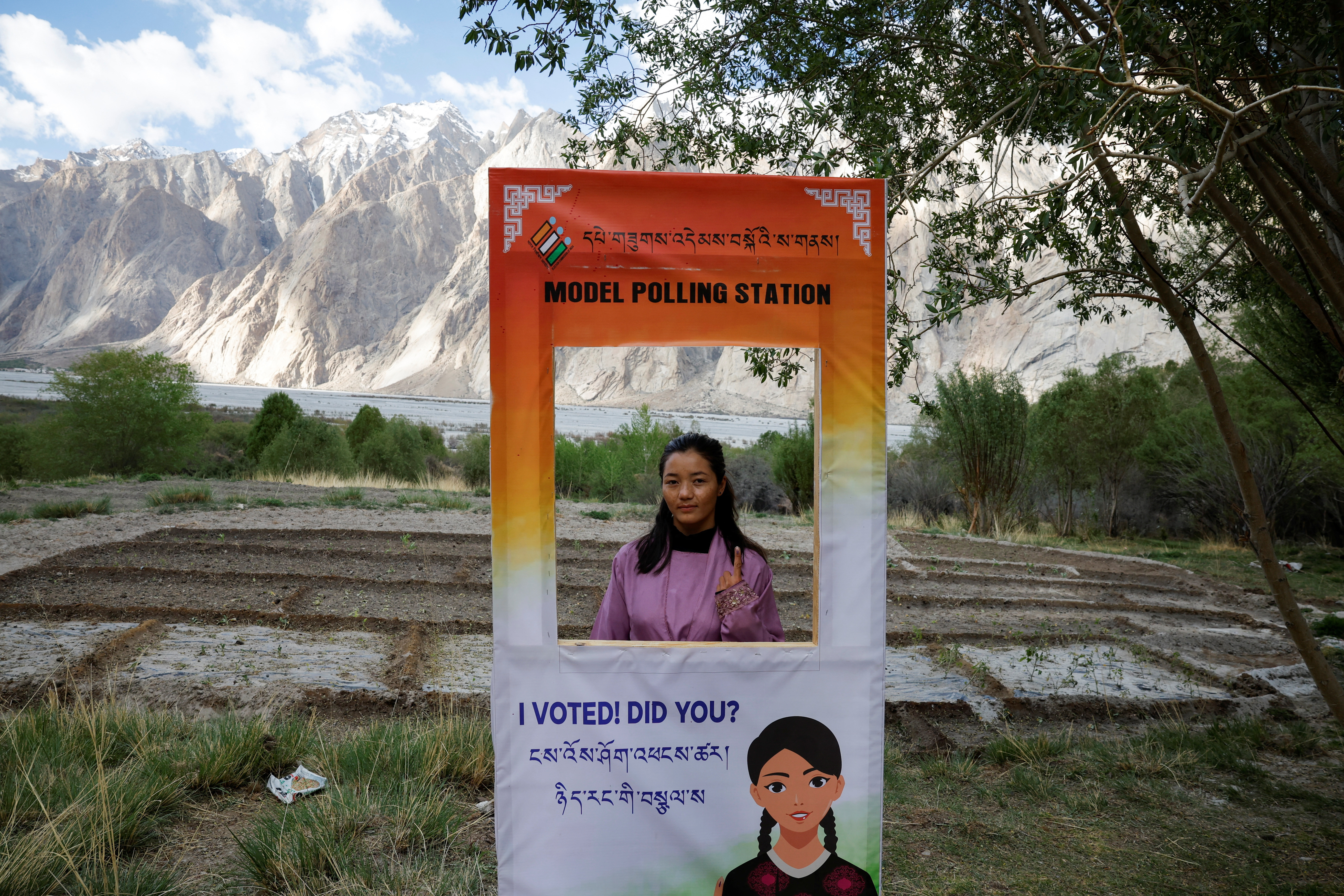
Russia's Slavyansk oil refinery, located in the Krasnodar region, was damaged after a weekend drone attack, state-run TASS reported on Monday, citing a company security official.
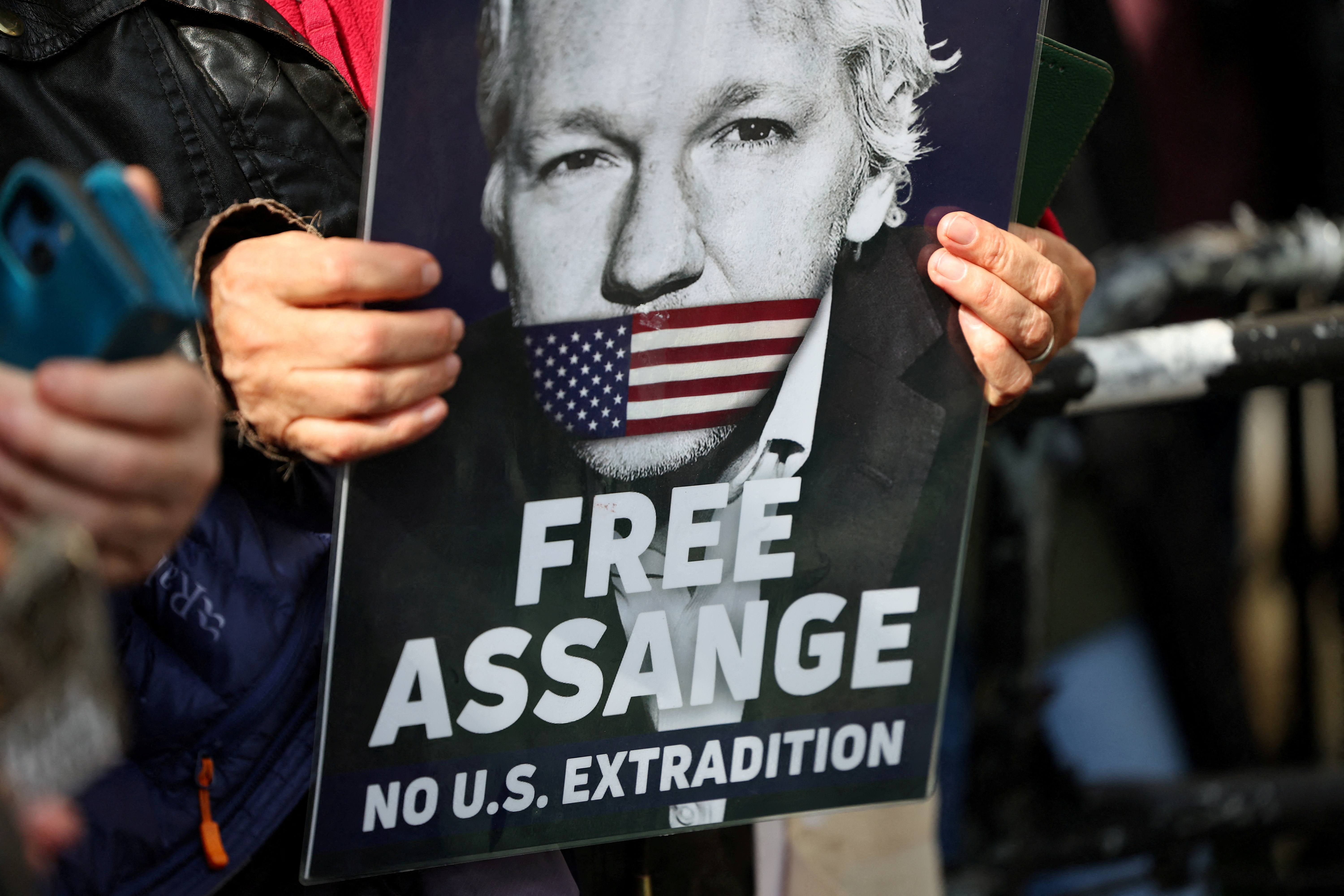
Facility for Rare Isotope Beams
At michigan state university, international research team uses wavefunction matching to solve quantum many-body problems, new approach makes calculations with realistic interactions possible.
FRIB researchers are part of an international research team solving challenging computational problems in quantum physics using a new method called wavefunction matching. The new approach has applications to fields such as nuclear physics, where it is enabling theoretical calculations of atomic nuclei that were previously not possible. The details are published in Nature (“Wavefunction matching for solving quantum many-body problems”) .
Ab initio methods and their computational challenges
An ab initio method describes a complex system by starting from a description of its elementary components and their interactions. For the case of nuclear physics, the elementary components are protons and neutrons. Some key questions that ab initio calculations can help address are the binding energies and properties of atomic nuclei not yet observed and linking nuclear structure to the underlying interactions among protons and neutrons.
Yet, some ab initio methods struggle to produce reliable calculations for systems with complex interactions. One such method is quantum Monte Carlo simulations. In quantum Monte Carlo simulations, quantities are computed using random or stochastic processes. While quantum Monte Carlo simulations can be efficient and powerful, they have a significant weakness: the sign problem. The sign problem develops when positive and negative weight contributions cancel each other out. This cancellation results in inaccurate final predictions. It is often the case that quantum Monte Carlo simulations can be performed for an approximate or simplified interaction, but the corresponding simulations for realistic interactions produce severe sign problems and are therefore not possible.
Using ‘plastic surgery’ to make calculations possible
The new wavefunction-matching approach is designed to solve such computational problems. The research team—from Gaziantep Islam Science and Technology University in Turkey; University of Bonn, Ruhr University Bochum, and Forschungszentrum Jülich in Germany; Institute for Basic Science in South Korea; South China Normal University, Sun Yat-Sen University, and Graduate School of China Academy of Engineering Physics in China; Tbilisi State University in Georgia; CEA Paris-Saclay and Université Paris-Saclay in France; and Mississippi State University and the Facility for Rare Isotope Beams (FRIB) at Michigan State University (MSU)—includes Dean Lee , professor of physics at FRIB and in MSU’s Department of Physics and Astronomy and head of the Theoretical Nuclear Science department at FRIB, and Yuan-Zhuo Ma , postdoctoral research associate at FRIB.
“We are often faced with the situation that we can perform calculations using a simple approximate interaction, but realistic high-fidelity interactions cause severe computational problems,” said Lee. “Wavefunction matching solves this problem by doing plastic surgery. It removes the short-distance part of the high-fidelity interaction, and replaces it with the short-distance part of an easily computable interaction.”
This transformation is done in a way that preserves all of the important properties of the original realistic interaction. Since the new wavefunctions look similar to that of the easily computable interaction, researchers can now perform calculations using the easily computable interaction and apply a standard procedure for handling small corrections called perturbation theory. A team effort
The research team applied this new method to lattice quantum Monte Carlo simulations for light nuclei, medium-mass nuclei, neutron matter, and nuclear matter. Using precise ab initio calculations, the results closely matched real-world data on nuclear properties such as size, structure, and binding energies. Calculations that were once impossible due to the sign problem can now be performed using wavefunction matching.
“It is a fantastic project and an excellent opportunity to work with the brightest nuclear scientist s in FRIB and around the globe,” said Ma. “As a theorist , I'm also very excited about programming and conducting research on the world's most powerful exascale supercomputers, such as Frontier , which allows us to implement wavefunction matching to explore the mysteries of nuclear physics.”
While the research team focused solely on quantum Monte Carlo simulations, wavefunction matching should be useful for many different ab initio approaches, including both classical and quantum computing calculations. The researchers at FRIB worked with collaborators at institutions in China, France, Germany, South Korea, Turkey, and United States.
“The work is the culmination of effort over many years to handle the computational problems associated with realistic high-fidelity nuclear interactions,” said Lee. “It is very satisfying to see that the computational problems are cleanly resolved with this new approach. We are grateful to all of the collaboration members who contributed to this project, in particular, the lead author, Serdar Elhatisari.”
This material is based upon work supported by the U.S. Department of Energy, the U.S. National Science Foundation, the German Research Foundation, the National Natural Science Foundation of China, the Chinese Academy of Sciences President’s International Fellowship Initiative, Volkswagen Stiftung, the European Research Council, the Scientific and Technological Research Council of Turkey, the National Natural Science Foundation of China, the National Security Academic Fund, the Rare Isotope Science Project of the Institute for Basic Science, the National Research Foundation of Korea, the Institute for Basic Science, and the Espace de Structure et de réactions Nucléaires Théorique.
Michigan State University operates the Facility for Rare Isotope Beams (FRIB) as a user facility for the U.S. Department of Energy Office of Science (DOE-SC), supporting the mission of the DOE-SC Office of Nuclear Physics. Hosting what is designed to be the most powerful heavy-ion accelerator, FRIB enables scientists to make discoveries about the properties of rare isotopes in order to better understand the physics of nuclei, nuclear astrophysics, fundamental interactions, and applications for society, including in medicine, homeland security, and industry.
The U.S. Department of Energy Office of Science is the single largest supporter of basic research in the physical sciences in the United States and is working to address some of today’s most pressing challenges. For more information, visit energy.gov/science.
Sen. Lindsey Graham says Israel should do 'whatever' it has to while comparing the war in Gaza to Hiroshima and Nagasaki
Sen. Lindsey Graham, R-S.C., on Sunday compared Israel’s war against Hamas to the U.S. decision to drop atomic bombs on Japan in World War II during an interview on NBC News’ “Meet the Press.”
“When we were faced with destruction as a nation after Pearl Harbor, fighting the Germans and the Japanese, we decided to end the war by the bombing [of] Hiroshima [and] Nagasaki with nuclear weapons,” Graham said. “That was the right decision.”
He added, “Give Israel the bombs they need to end the war. They can’t afford to lose.”
Graham, a staunch supporter of Israel, used the analogy multiple times while condemning President Joe Biden for threatening to withhold certain weapons from Israel if it launches a military operation in Rafah, the southernmost city in Gaza where over a million civilians are sheltering.
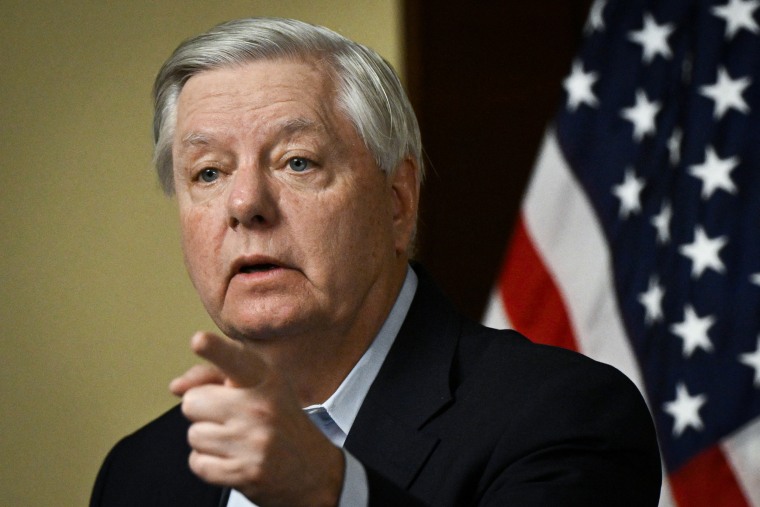
Asked by moderator Kristen Welker why it was OK for President Ronald Reagan to withhold certain weapons from Israel during its war in Lebanon in the 1980s, but not OK for Biden to threaten to do so now, Graham once again brought up World War II.
“Can I say this?” he asked. “Why is it OK for America to drop two nuclear bombs on Hiroshima and Nagasaki to end their existential threat war? Why was it OK for us to do that? I thought it was OK.”
He added, “So, Israel, do whatever you have to do to survive as a Jewish state. Whatever you have to do.”
Welker pushed back, telling Graham that U.S. military officials say technology has vastly changed since World War II, a point she made earlier in the interview as well.
“Yeah, these military officials that you’re talking about are full of crap,” Graham answered.
His comments came shortly after Secretary of State Antony Blinken joined the program and declined to identify a “ red line ” with Israel , telling Welker: “Absent a credible plan to get [civilians] out of harm’s way and to support them, the president’s been clear for some time that we couldn’t and would not support a major military operation in Rafah.”
Blinken also discussed U.S. concerns about the use of “high-payload” bombs, telling Welker, “We have been holding back and we’re in active conversations with Israel about the provision of heavy or high-payload weapons, large bombs, because of the concern that we have about the effect these weapons can have when they’re used in a dense urban environment like Rafah.”
Graham argued that Hamas is to blame for civilian casualties throughout the conflict.
“I think it’s impossible to mitigate civilian deaths in Gaza as long as Hamas uses their own population as human shields. I’ve never seen in the history of warfare such blatant efforts by an enemy — Hamas — to put civilians at risk,” he said.
“The last thing you want to do is reward this behavior,” Graham added.
Alexandra Marquez is a politics reporter for NBC News.

North Korea Intensifies Nuclear Capabilities, Tests Ballistic Missiles Amidst Rising Tensions
N orth Korean leader Kim Jong Un has directed an acceleration in the production of nuclear weapons, coinciding with the testing of tactical ballistic missiles sporting new guidance technology, as reported by state media KCNA. During a visit to an arms factory, Kim Jong Un emphasized the necessity to fortify nuclear war deterrence, with the rationale that it would instill fear in potential adversaries regarding North Korea’s nuclear combat readiness.
This strategic maneuver occurred amid a flurry of short-range ballistic missiles launched towards the sea off its east coast, as confirmed by South Korea’s military. Kim Jong Un expressed contentment with the successful tests, which arrived on the heels of joint air combat drills conducted by the U.S. and South Korea involving stealth fighter jets.
These developments signify a substantial uptick in tensions on the Korean Peninsula. It appears that North Korea is advancing its weapons program in response to what it perceives as U.S.-led hostilities, as well as joint military exercises that it interprets as invasion rehearsals.
Adding to the provocations, Kim Yo Jong, the sister of the North Korean leader, outlined that the nation’s recent tests are part of an arms build-up plan inaugurated in 2021. She stated that the weapons would be used to discourage Seoul from harboring any aggressive notions and refuted claims that these tests were exhibitions intended for arms export to Russia.
“We don’t conceal the fact that such weapons will be used to prevent Seoul from inventing any idle thinking,” Kim Yo Jong said in a statement carried by state media.
This series of missile launches and the explicit directive to accelerate nuclear production demonstrate a clear escalation in North Korea’s military posture. The North’s actions underscore a defiance towards international diplomatic efforts aimed at denuclearization and a persistence in developing its nuclear capabilities as a means of asserting its sovereignty and deterring perceived threats.
The responses from South Korea and the U.S. remain predominantly focused on increased military readiness and surveillance, reflecting the precarious balance of power in the region. The international community watches closely as the Korean Peninsula grapples with a tense and uncertain security landscape, where diplomatic resolutions seem increasingly distant.
Relevant articles:
– North Korea’s Kim accelerates production to shore up nuclear force, KCNA says , The Times of India, 05/18/2024
– North Korea fires suspected ballistic missiles following joint U.S. , Shafaq News, 05/17/2024
– As Trump heads to Davos, survey points to rising risk of war , Yahoo Singapore News, 05/15/2024
– North Korea Fires Short-Range Ballistic Missiles Toward East Sea: JCS , Ommcom News, 05/17/2024
– Olympics – IOC welcomes North Korean Olympic overture , Yahoo Eurosport UK, 05/16/2024
Glad you enjoyed above story, be sure to follow TrendyDigests on Microsoft Start.
![North Korean leader Kim Jong Un has directed an acceleration in the production of nuclear weapons, coinciding with the testing of tactical ballistic missiles sporting new guidance technology, as reported by state media KCNA. During a visit to an arms factory, Kim Jong Un emphasized the necessity to fortify nuclear war deterrence, with the rationale […] North Korean leader Kim Jong Un has directed an acceleration in the production of nuclear weapons, coinciding with the testing of tactical ballistic missiles sporting new guidance technology, as reported by state media KCNA. During a visit to an arms factory, Kim Jong Un emphasized the necessity to fortify nuclear war deterrence, with the rationale […]](https://img-s-msn-com.akamaized.net/tenant/amp/entityid/AA1o147X.img?w=768&h=512&m=6&x=105&y=981&s=3558&d=1717)
We've detected unusual activity from your computer network
To continue, please click the box below to let us know you're not a robot.
Why did this happen?
Please make sure your browser supports JavaScript and cookies and that you are not blocking them from loading. For more information you can review our Terms of Service and Cookie Policy .
For inquiries related to this message please contact our support team and provide the reference ID below.

COMMENTS
Desert, where more than a thousand nuclear weapons were exploded during the Cold War, are booked solid through 2014. Then there is the specter of nuclear meltdown. In 2011, Chernobyl, site of the world's worst catastrophe at a nuclear power plant, was officially declared a tourist attraction. Nuclear tourism.
Nuclear tourism. Coming around the time of the Fukushima disaster, the idea seems absurd. And that is what drew me, along with the wonder of seeing towns and a whole city—almost 50,000 people ...
See the stunning images of tourism in the Chernobyl Exclusion Zone by Gerd Ludwig, published in National Geographic Magazine. Learn more about the photographer, his book, and his interview in the German edition of NG.
The Nuclear Tourist. Paperback - February 18, 2017. In the brutal confines of The Facility, the most brilliant minds in history are resurrected and cloned. Isolated and approaching breaking point, at just seventeen Dane is one of their rising stars. Sent to Chernobyl to investigate a series of inexplicable deaths, linked only by the presence ...
The Virtual Nuclear Tourist - Questions about Nuclear Power !!!! A revision to the site is in progress to eliminate broken links and update the site about new reactor trends and designs. My intent is to make more use of PDF pages and combine pages, where appropriate. Due toa a request from some who use the website for online courses, I will ...
Atomic tourism or nuclear tourism is a form of tourism in which visitors witness nuclear tests or learn about the Atomic Age by traveling to significant sites in atomic history such as nuclear test reactors, museums with nuclear weapon artifacts, delivery vehicles, sites where atomic weapons were detonated, and nuclear power plants. [1] [2]
In the brutal confines of The Facility, the most brilliant minds in history are resurrected and cloned. Isolated and approaching breaking point, at just seventeen Dane is one of their rising stars. Sent to Chernobyl to investigate a series of inexplicable deaths, linked only by the presence of a rare nuclear isotope, an accident propels Dane ...
After the nuclear disaster at Chernobyl in 1986, more than a thousand square miles were abandoned, inspiring the curious and adventurous to sneak into the exclusion zone. ... "The Nuclear Tourist ...
Welcome to the new Virtual Nucleartourist.This site is a revision of the prior version which had operated for ~4.5 years. The 300+ page site about nuclear power plants was developed because I've found that most of what the general public hears or sees about nuclear power plants is on TV or in the newspapers and frequently that coverage is incomplete.
Step inside Cold War nuclear sites. Contemplating cataclysmic destruction isn't exactly relaxing. So why do hundreds of thousands of tourists visit these decommissioned missile sites? These suits ...
Hugh Gusterson. This essay describes a new post‐war pilgrim—the nuclear tourist who visits the sites where the first nuclear bombs were created and tested. Some such pilgrims are history enthusiasts, some are impelled by diffusely patriotic impulses, and others go to protest nuclear weapons. All go to "imagine the real"—or at least ...
Nuclear Tourism: When atomic tests were a tourist attraction in Las Vegas, 1950s. Las Vegas is known as the city of lights and, at one time, that light was the glow of an atomic detonation in the Nevada desert. Starting in 1951, the US Army began testing nuclear ordnances just 65 miles from Sin City.
NATIONAL GEOGRAPHIC MAGAZINE PUBLISHES "THE NUCLEAR TOURIST" SEPTEMBER // 2014. After the publication of his 20-year retrospective “The Long Shadow of Chernobyl†Gerd Ludwig continues to explore the aftermath of the world’s worst nuclear disaster to date. In a story titled “THE NUCLEAR TOURIST,†the October issue of National Geographic Magazine USA and several of ...
Nuclear tourism. 30°0′0″N 10°0′0″W. Map of Nuclear tourism. Nuclear tourism is travel to places connected with nuclear history, nuclear science, and nuclear technology. This can include historical sites of nuclear detonations or places related to peaceful or wartime use of nuclear energy. Sites of interest to the nuclear tourist may ...
Read this passage from "The Nuclear Tourist." "A few minutes later we reached Zalesye, an old farming village, and wandered among empty houses. . . . On the floor of one home a discarded picture of Lenin—pointy beard, jutting chin—stared sternly at nothing, and hanging by a cord on a bedroom wall was a child's doll.
Timothy Karpin and James Maroncelli, authors of The Traveler's Guide to Nuclear Weapons and founders of AtomicTraveler.com, have visited some 160 sites across the nation that had some role in ...
The Nuclear Tourist author. George Johnson. basic plot. The story is set after the explosion at the Chernobyl Nuclear Power Point in Pripyat, Ukraine. The story is about the new tourism that has began 28 years after the explosion because people are interested in the affects of the disaster and the "ghost town".
McGee of 303 and Learnstrong.net lectures from the Freshman edition of the MyPerspectives text: Pages 742-757: George Johnson's The Nuclear Tourist, A
If you have a question regarding nuclear science, power generation, regulation, or safety, you may want to scroll through the index on the Virtual Nuclear Tourist homepage or the list of questions on the FAQ page . There are currently over 300 pages on the site. Other sources for answers to some frequently asked questions that have been kindly ...
The Nuclear Tourist - Free download as PDF File (.pdf), Text File (.txt) or read online for free. Scribd is the world's largest social reading and publishing site.
The Nuclear Tourist. 1. Multiple Choice. What is the exclusion zone? 2. Multiple Choice. What are some characteristics that draw tourists to areas like Chernobyl? 3. Multiple Choice.
The Nuclear Tourist delivers. A consortium of young scientists are Sent to Chernobyl, to investigate a series of violent deaths on the premise. Could the ruined bowels of the reactor have spawned some kind of a mutant?
The Nuclear Tourist. 1. Multiple Choice. What is the exclusion zone? 2. Multiple Choice. What are some characteristics that draw tourists to areas like Chernobyl? 3. Multiple Choice.
White House National Security Adviser Jake Sullivan will visit Saudi Arabia this weekend for talks expected to touch on a civil nuclear cooperation agreement, one piece of a wider arrangement ...
New approach makes calculations with realistic interactions possibleFRIB researchers are part of an international research team solving challenging computational problems in quantum physics using a new method called wavefunction matching. The new approach has applications to fields such as nuclear physics, where it is enabling theoretical calculations of atomic nuclei that were previously not ...
The GOP senator compared Israel's military operations to the U.S. dropping atomic bombs on Japan in World War II, saying, "Israel, do whatever you have to do."
To show it shares Saudi concerns about Iran's nuclear program, the Biden administration must work with France, Britain and Germany to formally end the nuclear deal, restore UN Iran sanctions ...
During a visit to an arms factory, Kim Jong Un emphasized the necessity to fortify nuclear war deterrence, with the rationale that it would instill fear in potential adversaries regarding North ...
Alignment on shared frictions This week's visit marks the leaders' 43rd meeting in the more than one decade that Xi has been in power. Xi and Putin, known for their close personal chemistry ...
Chinese President Xi Jinping and Russian leader Vladimir Putin pledged to intensify cooperation against US "containment" of their countries, as they warned of growing nuclear tensions between ...